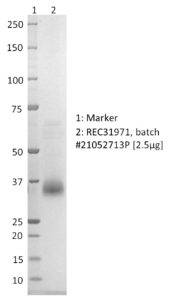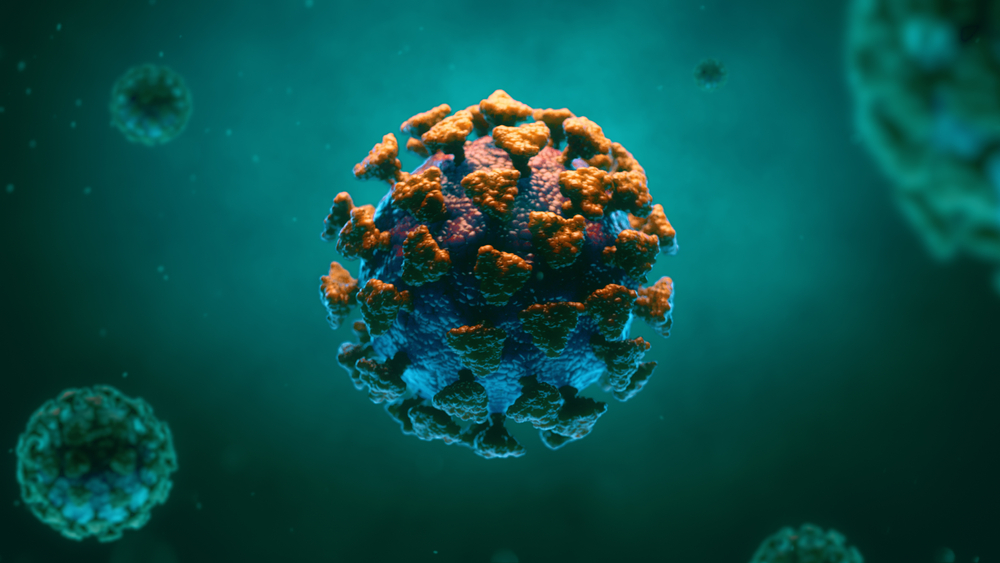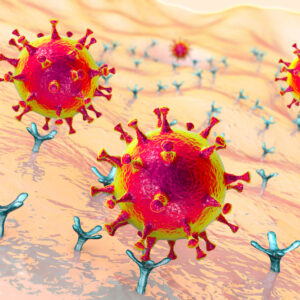
SDS-PAGE: Coomassie-stained SDS-PAGE showing purified SARS-CoV-2 RBD with E484Q and L452R mutations.
SARS-CoV-2 (B.1.617.1) Spike Glycoprotein (S1) RBD, His-Tag (HEK293)
$652.44 – $2,486.76 excl. VAT
KERALA (KAPPA) VARIANT
SARS-CoV-2 (B.1.617.1) RBD mutant from the Kerala variant. Contains amino acid changes E484Q, L452R relative to Wuhan Hu-1. The protein was produced in HEK293 cells and purified from culture supernatant. SARS-CoV-2, previously known as the 2019 Novel Coronavirus (2019-nCoV), causes the pandemic COVID-19 disease.
SARS-COV-2 (B.1.617.1) SPIKE GLYCOPROTEIN (S1) RBD, HIS-TAG (HEK293)
SARS-CoV-2 (B.1.617.1) RBD mutant from the Kerala variant. Contains amino acid changes E484Q, L452R relative to Wuhan Hu-1. The protein was produced in HEK293 cells and purified from culture supernatant. SARS-CoV-2, previously known as the 2019 Novel Coronavirus (2019-nCoV), causes the pandemic COVID-19 disease.
PRODUCT DETAILS – SARS-COV-2 (B.1.617.1) SPIKE GLYCOPROTEIN (S1) RBD, HIS-TAG (HEK293)
- SARS-CoV-2 (B.1.617.1) Spike RBD.
- SARS-CoV-2 (B.1.617.1) RBD contains E484Q, L452R mutations relative to Wuhan Hu-1.
- Expressed in HEK293 and purified by affinity chromatography.
- Presented in DPBS at
BACKGROUND
Severe acute respiratory syndrome coronavirus 2 (SARS-CoV-2) is the virus that causes coronavirus disease 2019 (COVID-19). The sequence WIV04/2019, belonging to the GISAID S clade / PANGOLIN A lineage / Nextstrain 19B clade, is believed to be the original sequence infecting humans (Zhukova et al., 2020). However, there are many thousands of variants of SARS-CoV-2 (Koyama et al., 2020) and subtypes of the virus can be placed into much larger groupings such as lineages or clades.
B.1.617, also known as the “double mutant” variant, was first detected in India in October 2020. Since then, three sub lineages of this variant have been detected, namely B.1.617.1, B.1.617.2 and B.1.617.3. The B.1.617.2 is extremely transmissible and is the fourth strain of the SARS-CoV-2 virus to have undergone a mutation toward a more virulent and transmissible form. The B.1.617 lineage possesses 13 to 17 mutations, three of which are in the virus’ spike protein. The E484Q mutation appears to confer the virus increased binding capacity to the human ACE2 receptor and better ability to evade the immune system compared to other variants. The L452R mutation provides a similar enhancement of functions as the E484Q. The third mutation, P681R, may increase the infectivity of the virus particles by facilitating the splicing of a unique precursor protein into its active infective conformation. B.1.617.1 shows potential reduction in neutralization by some monoclonal antibody treatments and reduction in neutralization by post-vaccination sera (WHO; CDC).
REFERENCES
- CDC. SARS-CoV-2 Variant Classifications and Definitions.
- Koyama T, Platt D, Parida L. Variant analysis of SARS-CoV-2 genomes. Bull World Health Organ. 2020 Jul 1;98(7):495-504.
- Zhukova A, Blassel L, Lemoine F, Morel M, Voznica J, Gascuel O. Origin, evolution and global spread of SARS-CoV-2. C R Biol. 2020 Nov 24. doi: 10.5802/crbiol.29.
- WHO. Tracking SARS-CoV-2 variants.


